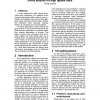Free Online Productivity Tools
i2Speak
i2Symbol
i2OCR
iTex2Img
iWeb2Print
iWeb2Shot
i2Type
iPdf2Split
iPdf2Merge
i2Bopomofo
i2Arabic
i2Style
i2Image
i2PDF
iLatex2Rtf
Sci2ools
SIGMOD
2006
ACM
2006
ACM
B-tree indexes for high update rates
ct In some applications, data capture dominates query processing. For example, monitoring moving objects often requires more insertions and updates than queries. Data gathering using automated sensors often exhibits this imbalance. More generally, indexing streams is considered an unsolved problem. For those applications, B-tree indexes are good choices if some trade-off decisions are tilted towards optimization of updates rather than towards optimization of queries. This paper surveys some techniques that let Btrees sustain very high update rates, up to multiple orders of magnitude higher than traditional B-trees, at the expense of query processing performance. Not surprisingly, some of these techniques are reminiscent of those employed during index creation, index rebuild, etc., while other techniques are derived from well known technologies such as differential files and log-structured file systems.
Capture Dominates Query | Database | Log-structured File Systems | Query Processing Performance | SIGMOD 2006 |
| Added | 08 Dec 2009 |
| Updated | 08 Dec 2009 |
| Type | Conference |
| Year | 2006 |
| Where | SIGMOD |
| Authors | Goetz Graefe |
Comments (0)

